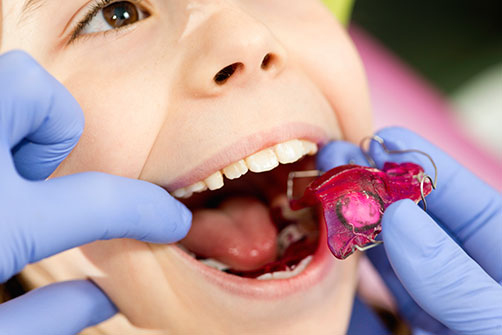Orthodontics for Children
Early orthodontic evaluation and treatment can help you get your children off to a great start with their oral health.
If you think your child may need orthodontic treatment, we're here to help put your concerns to rest!
How old should my child be when she visits the orthodontist for the first time?
In many cases, orthodontic problems are easier to correct, the earlier they're detected.
This is why the Canadian Association of Orthodontists recommends that children should visit the orthodontist for the first time by the age 7.
Some children may not require treatment until between the ages of 11 to 13, but since the first permanent molars and incisors have usually come in around age 7, issues like crossbites, crowding and other problems can be evaluated and monitored at this early age.
Can the orthodontist even do anything to correct bite problems while a child still has his or her baby teeth?
Yes: in certain cases, orthodontic problems can be significant enough to require intervention earlier than usual. This early stage of treatment is generally referred to as phase I treatment. Of course, if a patient is not yet ready for treatment, we will monitor his or her growth and development until the time is right for treatment to begin.
What does Phase I Treatment involve?
Phase I, otherwise known as early interceptive treatment, involves limited forms of orthodontic treatment (e.g., expanders or partial braces) that take place before all the child's permanent teeth have erupted.
These types of treatment usually begin between the ages of 6 and 10. Early treatment may be recommended to make more space for developing teeth, or correction of crossbites, overbites, underbites, or harmful oral habits.
If my child has Phase I Treatment, will full braces still be necessary?
Most of the time, Phase I treatment is done in preparation for Phase II treatment. So in short, yes: it is quite likely that your child will eventually need full braces.
However, early treatment can make future orthodontic treatment go much more smoothly and efficiently. It can help to regulate the width of the upper and lower dental arches, create space for permanent teeth to erupt correctly, prevent the need to extract permanent teeth, reduce the likelihood of impacted permanent teeth, correct thumb-sucking habits, and help eliminate abnormal speech or swallowing problems.
Essentially, Phase I treatment can help make Phase II treatment easier on your child in the long run.

What problems can develop at an early age?
There are many reasons that a child may need orthodontic treatment at an early age, and early phase treatment may also reduce or prevent the need for more invasive treatment when your child is older.
When treatment is initiated at a young age, your child's orthodontist can make efforts to guide the growth of the jaw (Dentofacial Orthopedics) and the emerging permanent teeth.
All of the following issues may be treated with early (phase I) orthodontics:
- Thumb-sucking
- Trouble with chewing and breathing
- Late or early loss of baby teeth
- Teeth that are crowded, loose, or impacted
- Upper and lower teeth that do not meet correctly
- Improper jaw alignment
- Tongue thrusting
- Crossbites
